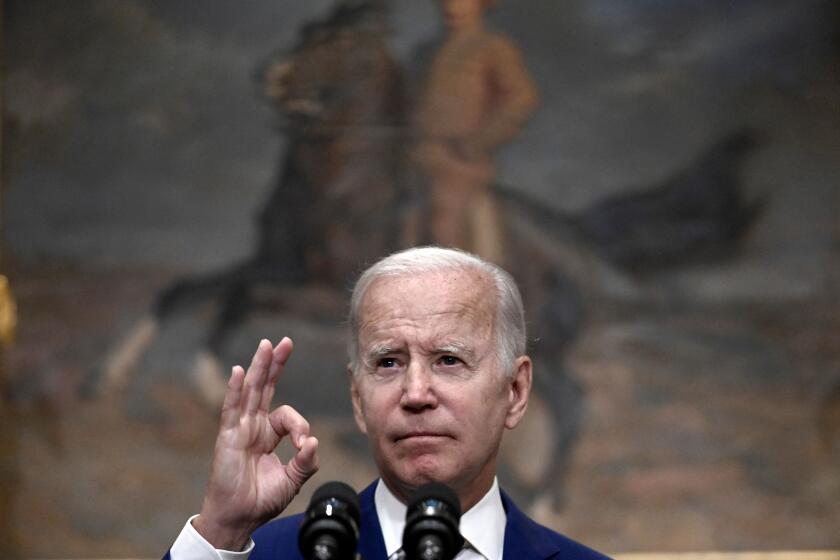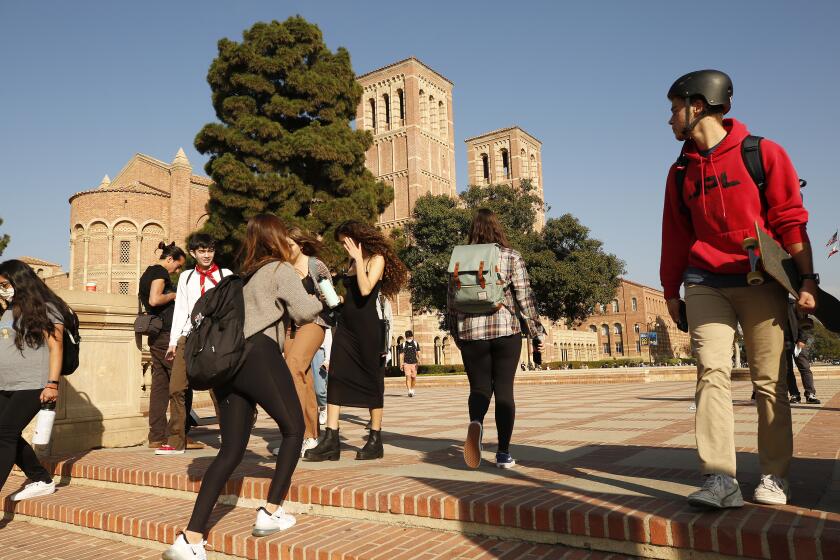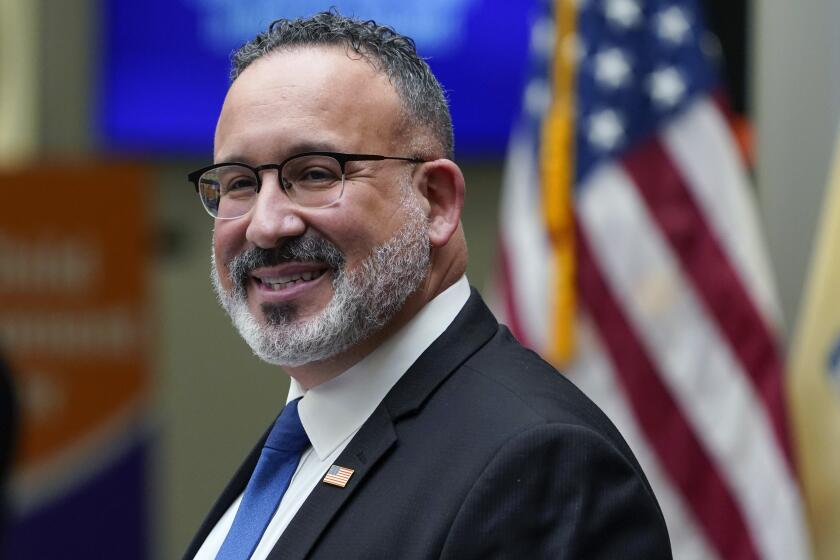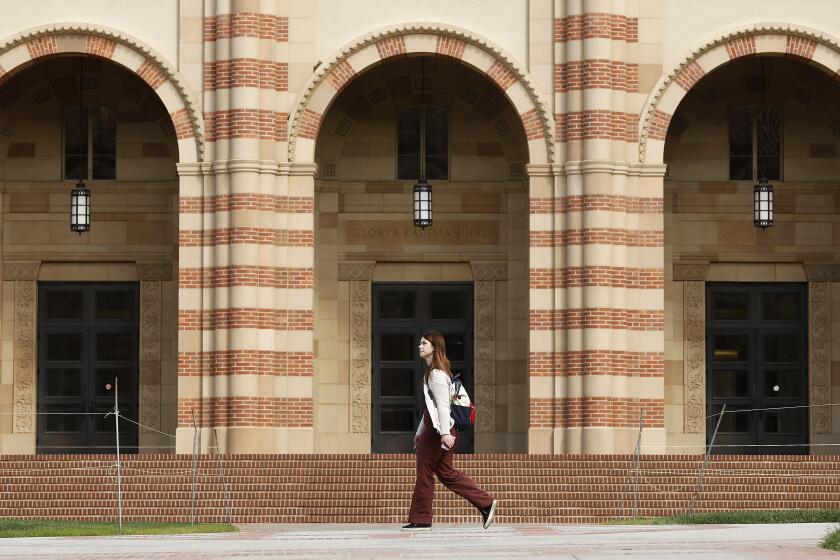Student loan forgiveness: Everything you need to know

President Biden announced Wednesday that he is canceling $10,000 in student debt for individuals earning less than $125,000 annually.
- Share via
Relief is coming soon to millions of Californians burdened by student loan debt. For many, though, the debt forgiveness offered by the Biden administration will just lighten the load, rather than remove it entirely.
Also, after a years-long pause triggered by the pandemic, borrowers will have to start making payments on their federal student loans in January. The administration is also proposing a rule that would reduce future payment burdens for borrowers with low post-college earnings.
For the record:
11:34 a.m. Aug. 26, 2022This story states that having your loan forgiven would not increase your taxes. It will not increase your federal taxes, but the amount forgiven will be treated as taxable income by the state of California, with limited exceptions.
An earlier version of this article also stated that Californians owed about $28.5 billion in student loan debt, according to the Education Data Initiative. The total debt is $141.8 billion, according to the site.
More than 45 million current and former college and trade school students have racked up $1.6 trillion in federal loan debt across the country. About $142 billion of that belongs to 3.8 million Californians, which translates into an average debt of $37,000, according to the Education Data Initiative. About 92% of those borrowers will be eligible for the new loan forgiveness, UC Merced economist Charlie Eaton estimated.
How much is the loan forgiveness, and what are the limits?
The administration announced Wednesday that it would forgive up to $10,000 in federal student loan debt — that is, erase it from the books. This relief will be available to borrowers who earned less than $125,000 a year (or married couples earning less than $250,000). For borrowers who received Pell Grants and meet the income limit, the amount of debt forgiveness will double to up to $20,000.
Pell Grants are a form of federal aid available to low- and moderate-income undergraduate students. Unlike student loans, they do not have to be repaid.
The announcement did not specify when the debt forgiveness would take effect but suggested that it would be by the end of the year.
President Biden has decided to forgive some student debt. The political fallout could be significant.
The income limit is designed to confine the aid to struggling borrowers, not high earners. According to the administration, 87% of the benefits would go to borrowers earning $75,000 a year or less.
But it also means the Education Department can’t grant forgiveness automatically to every eligible borrower. Instead, borrowers whose income information isn’t already filed with the department will have to apply and demonstrate that they meet the limit.
To give borrowers time to file any necessary applications, the administration will continue the current moratorium on college loan payments and interest until the end of the year.
What about loans taken out by parents?
Federal Parent Plus loans are eligible for forgiveness if the parents’ income is less than the limit of $125,000 for a single filer or $250,000 for a married couple.
In the case of student borrowers who are claimed as dependents by their parents, their eligibility for loan forgiveness will depend on their parents’ income.
What do I have to do right now?
According to the Biden administration, “nearly 8 million borrowers may be eligible to receive relief automatically because relevant income data is already available to the U.S. Department of Education.”
If you believe you are qualified for loan forgiveness but aren’t sure whether your income information is on file, you can apply for the relief by filling out a simple form that the White House said would be available by the end of the year.
To be notified when the application form is available, visit the Department of Education subscription page. No deadline for the application has yet been announced.
Borrowers should make sure that their federal account is up to date and that they know which company is servicing their loans. For help finding that information, check the Federal Student Aid website or call (800) 433-3243.
What if I have a private loan?
The action doesn’t affect student loans issued by private lenders, just the ones directly from the federal government. But private loans make up less than 10% of total student loan debt in the U.S.
The White House said Pell Grant recipients would receive twice as much loan forgiveness as other low- and moderate-income borrowers. Do you qualify? Check the Federal Student Aid website.
How will my monthly payments be affected?
Once payments resume in January, borrowers enrolled in income-driven repayment plans whose debts are not completely forgiven will pay the same percentage of their income that they paid before the pandemic-related moratorium. In other words, unless their income is lower, the debt relief won’t lower their payments.
But by reducing the total that borrowers owe, the relief plan could cut the number of years it will take to pay off their debts.
For borrowers enrolled in standard plans who owe more than will be forgiven, the new relief offers a choice:
- Continue making the same monthly payments but pay off their loans sooner, or
- Reduce monthly payments but stick with the 10-year payoff period. If you fall into this category, you should contact your loan servicer to discuss your options while waiting for the forgiveness to take effect.
Will loan forgiveness raise my taxes?
The relief announced Wednesday will not be treated as income on your taxes.
If I’ve already paid off my loans, can I get a refund?
No.
Here are the details of CalKIDS, which automatically creates a college savings plan for newborn Californians and offers up to $1,500 for low-income kids in primary and secondary school.
How are loans paid back?
There are two basic ways to pay off federal loans, each with multiple variations and options. Under the “standard” repayment plan and its variations, borrowers pay a fixed amount every month for 10 years — or 25 to 30 years for those with larger debts — until their balance is zero.
Under “income-driven repayment” plans, borrowers typically pay 10% of their discretionary income (that is, gross income minus an allowance for living expenses) each year for up to 20 years; any remaining debt is forgiven (although after 2025, they’ll have to pay taxes on the forgiven amount, which the Internal Revenue Service classifies as income).
Roughly a third of federal borrowers are in income-driven plans, which have lower monthly payments — even no payment at all, for very-low-income or unemployed borrowers — but can collect more in interest than the shorter standard plans. According to the Congressional Budget Office, the typical borrower’s debt actually grows under the program because the monthly payments aren’t large enough to cover the interest accrued. As more borrowers enrolled in these plans, the CBO said, the rate at which borrowers repaid student loans slowed. In other words, more Americans were burdened longer with student loan debt.
Borrowers with income-based repayment plans have to recertify their income annually to stay in the program. If they don’t, their payments will increase to the standard plan amount based on a 10-year payback, and the interest they’ve accrued is converted into principal (“capitalized”) and subjected to interest charges.
How will income-driven plans change?
The administration is proposing a rule that would slash the cost of loan repayment for borrowers in the income-driven repayment program. This proposal would:
- Cap monthly payments at 5% of discretionary income instead of the current 10%;
- Reduce the amount of income considered “discretionary,” lowering the monthly payment amounts;
- Forgive loans after 10 years of repayments for borrowers who owe $12,000 or less, and
- Prevent loan balances from growing by having the federal government cover the difference between the borrower’s monthly payment and the amount of interest owed.
Those changes respond to some of the main complaints from borrowers, who say the programs that were designed to make college more affordable instead wind up trapping them in debt for decades.
“We have a mailing list of over 2 million people,” said Abrams of the Student Debt Crisis Center. “I’d say 95% or more ... say, ‘I want to pay this back. I’ve been trying for 10 years, 20 years....’ A student loan was never intended to be a mortgage.”
How will the Department of Education’s recalculation of student loan debts affect you? Here’s what they’re doing and how to figure it out.
What other help is available?
Jaylon Herbin, a student loan expert with the Center for Responsible Lending, pointed to two other sources of help the administration offers: expanded loan forgiveness for borrowers who take public-service jobs, and the Fresh Start program for borrowers in default.
Borrowers have until Oct. 31 to apply for the Public Service Loan Forgiveness plan, which wipes out loan debt for people who make timely payments for 120 months while working full time for the government or a qualifying nonprofit organization. The administration extended eligibility retroactively to borrowers with certain types of federal loans that were not previously included, as well as those with federal direct loans who worked for qualified employers but had not certified their eligibility.
You can apply for retroactive inclusion at the Federal Student Aid website; you’ll need the most recent tax form you received from your employer or your company’s federal employer identification number. Borrowers with some uncommon types of federal loans will have to consolidate them into a federal direct loan to qualify.
The Fresh Start program gives borrowers in default the option to bring their accounts back into good standing and start paying down their loan balances again. Applications will be accepted until the end of 2023, but if you’re in default you’ll want to get into the program before the end of this year. Otherwise, debt collection efforts will resume on your loan in January, when the pandemic-related moratorium ends.
Getting out of default will restore your eligibility for federally backed mortgages and other loans, as well as income-driven repayment plans and loan forgiveness programs.
Who has all this debt?
Federal loans are available in some form to anyone pursuing a degree after high school. Lower-income students can obtain up to $23,000 in loans that do not start accruing interest until they leave school, plus up to $8,000 (if they are still someone’s dependents; if not, up to $34,500) in unsubsidized loans that start accruing interest the minute their college receives the money — even though they’re not required to make payments while they’re enrolled. As a result of the compounding interest, they may owe thousands of dollars more the day they graduate than it cost them to attend.
Roughly 1 in 10 Californians still owe some student loan debt, and nearly half of them are older than 35, according to the Education Data Initiative. Of those with debt, 16% owe less than $5,000, and a little less than 3% owe more than $200,000.
The administration said that more than 60% of borrowers received Pell Grants, making them potentially eligible for $20,000 in debt relief. The percentage may be lower in California, though; only a third of California undergraduates in 2019-20 received Pell Grants.
How much will it cost, and why is the federal government doing it?
Forgiving the first $10,000 in student loan debt for those who earn up to $125,000 will cost taxpayers an estimated $300 billion, according to the University of Pennsylvania’s Penn Wharton Budget Model. That doesn’t include the estimated $20 billion it will cost to extend the moratorium on loan payments through the end of the year — a delay that benefits rich and poor borrowers alike.
Some economists warn that freeing up billions of dollars through loan forgiveness will make inflation worse, although that point is in dispute. Other critics argue that there is a moral hazard in writing off the costs that only some Americans chose to incur.
Beyond that, some critics say it’s not fair for the government to pick winners and losers by favoring current college debt over other borrowers and other needs. Responding to a debt-forgiveness activist on Twitter, Rep. Adam Kinzinger (R-Ill.) tweeted, “Hopefully you plan to cancel the debt of those who didn’t go to college, like the truck driver who is paying off his truck? Or the barber paying off his equipment?”
Advocates for debt relief, on the other hand, say the Federal Student Aid program has trapped too many people in debt through bad management and predatory practices. The Biden administration has been addressing some of those through reforms in programs that tie loan repayments to the borrower’s income after college and eliminate the debts of students who held public-service jobs, became permanently disabled or were defrauded by their schools (e.g., the ones who enrolled in Corinthian Colleges).
Until 1970, tuition was free at the University of California. That’s not coming back, but we mustn’t lose sight of accessibility and affordability.
What is the source of the problem?
At the heart of the debt problem is the high cost of college — an issue that loan reforms and one-shot debt forgiveness do not address. Too many students and their families take on more debt than their post-college careers can support, and colleges don’t have an incentive to stop students from doing so, said philanthropist Scott MacDonald, author of “Education Without Debt: Giving Back and Paying It Forward.”
MacDonald says a lack of financial literacy among students and parents leaves them vulnerable to the debt trap. College financial aid officers will tell students, “You don’t have to pay anything, just sign these papers,” MacDonald said. “Then they take these kids, they don’t mentor them, they just throw them in, and lo and behold the kids drop out of school and default on their loans. That school has zero liability.”
A few years ago, he said, Indiana University decided to tell students not only how much they were borrowing, but also their likely earnings in their chosen fields of study. “Lo and behold, kids started borrowing less money,” he said. “So financial literacy is a huge deal.”
For families of modest means, though, loans are the key that opens the gate to college. And income disparities before and after graduation make the debt burden fall harder on women and Black and Latino Americans, researchers say.
“High levels of debt burden mortgage young people’s minds, redline our schools, and discourage capable, hardworking people from getting advanced training and giving back to society,” said Jeanne Scheper, a debt-forgiveness advocate and author who chairs the Department of Gender and Sexuality Studies at UC Irvine. “Debt is not a personal failure but is a result of persistent structures of inequality.”
Times staff writers Debbie Truong and Teresa Watanabe contributed to this report.
About The Times Utility Journalism Team
This article is from The Times’ Utility Journalism Team. Our mission is to be essential to the lives of Southern Californians by publishing information that solves problems, answers questions and helps with decision making. We serve audiences in and around Los Angeles — including current Times subscribers and diverse communities that haven’t historically had their needs met by our coverage.
How can we be useful to you and your community? Email utility (at) latimes.com or one of our journalists: Jon Healey, Ada Tseng, Jessica Roy and Karen Garcia.
More to Read
Sign up for Essential California
The most important California stories and recommendations in your inbox every morning.
You may occasionally receive promotional content from the Los Angeles Times.
















